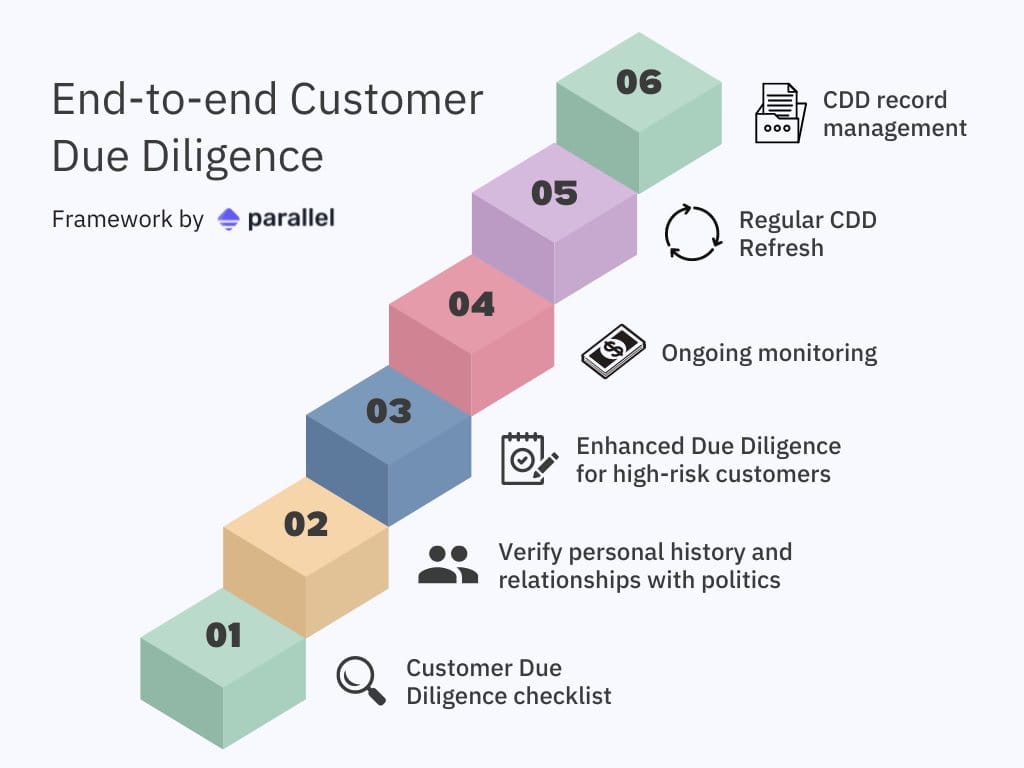Mastering the end to end Customer Due Diligence process

In the intricate web of modern financial transactions, ensuring the security and legality of operations is paramount for banks and financial entities. Customer Due Diligence (CDD) emerges as a crucial element in safeguarding businesses from financial fraud, corruption, and terrorist financing.
We’ll explore the end-to-end CDD process, reviewing each step and highlighting the frequent questions on a CDD form. Let’s go!
What is Customer Due Diligence (CDD)?
Customer Due Diligence is a critical process used by companies, particularly within the bank industry and financial sector, to assess the risk of their customers.
CDD is a fundamental aspect of an effective anti-money laundering (AML) program, mandated by various international and national regulations, and the process involves gathering relevant information about the customer to assess the viability of the business relationship.
The objectives of CDD are manifold:
- Verify the identity of the customer: Ensuring that the customer is who they claim to be.
- Understand the nature of the customer’s activities: Gaining insight into the source of the customer's funds and the intended nature of the business relationship.
- Make decisions based on associated money laundering risks: Evaluate the potential risks involved in business dealings with the customer, and tailor the monitoring of the case accordingly.
Effective CDD processes not only comply with regulatory requirements but also help in building safer, more transparent financial operations. They enable institutions to avoid reputational damage and financial losses due to associations with fraudulent activities.
End to end Customer Due Diligence
Implementing an end-to-end Customer Due Diligence (CDD) process is critical for organizations to effectively manage risks associated with money laundering. This comprehensive approach ensures that every stage of customer engagement is covered—from initial contact through to the ongoing management of the business relationship.

Customer Due Diligence checklist
The process begins with collecting basic identifying information from potential clients. This typically includes full name, address, date of birth, and identification numbers. Businesses may use forms, online applications, or face-to-face meetings to collect this data.
Go here the standard questions to manage a CDD process.
Once the basic information is collected, the next step is to verify that the information is accurate. This can involve checking government-issued IDs, using biometric verification, or cross-referencing with other reliable sources. For corporate clients, it may also include verifying the legal status of the company through business registration documents.
Verify personal history and relationships with politics
In the comprehensive framework of end-to-end Customer Due Diligence, a critical aspect is the thorough verification of a customer's personal history and their relationships with political figures or activities. This process is crucial in identifying potential risks associated with illegal activities.
Legal and Criminal Records:
Reviewing any legal issues, including past litigations and criminal records, is vital. This examination helps in assessing the integrity and ethical standing of the customer, which are important factors in establishing a business relationship.
Identifying Politically Exposed Persons (PEPs):
Special attention is given to individuals who are or have been involved in prominent public functions, known as Politically Exposed Persons (PEPs). The relationships of the customer with such individuals are scrutinized due to the higher risks of corruption and bribery associated with these positions.
Enhanced Due Diligence for high-risk customers
For customers classified as high risk, Enhanced Due Diligence (EDD) is required. This may involve obtaining additional information about the source of their funds, their latest payslip, the purpose of their transactions, and other relevant details
Ongoing monitoring
For customers identified as PEPs or those having close associations with them, ongoing monitoring is essential. This includes keeping track of their political involvements and any significant changes that could affect their risk profile.
In addition, ongoing transaction monitoring is essential to spot patterns that may indicate money laundering or other illegal activities. Automated systems are often used to flag transactions that fall outside of normal patterns for further investigation.
Regular CDD Refresh
Implementing a Customer Due Diligence refresh program is essential for maintaining accurate and current customer profiles. This practice helps financial institutions adapt to any changes in their clients' status or risk levels, ensuring ongoing compliance with anti-money laundering regulations.

Regularly refreshing CDD data not only supports effective risk management but also enhances the institution's ability to respond proactively to potential compliance issues. This dynamic approach is critical for adapting to the evolving regulatory landscape and maintaining the integrity of financial operations.
CDD record management
Effective record management is critical in maintaining compliance with anti-money laundering (AML) regulations. Financial institutions must retain all relevant CDD documents, including identification data, transaction records, and risk assessments, for a period mandated by law—typically five to ten years.
These records prove compliance during audits and inquiries by demonstrating adherence to AML protocols. Records should be secured against unauthorized access yet accessible for regulatory review. Digital documents must be encrypted and stored securely, while physical records should be managed in controlled environments.
Customer Due Diligence form (questions)
A well-structured Customer Due Diligence form is essential for collecting the necessary information to perform due diligence effectively. The form should be comprehensive yet straightforward, designed to gather detailed and relevant data. Here you have a template for adapting your CDD form.
Customer Due Diligence frequent questions
Here are key questions that are typically included in a CDD form:
- Personal Identification Information:
- What is your full name?
- What is your date of birth?
- What is your ID Number? (Choose the ID format)
- What is your permanent address?
- What is your tax residence address?
- Financial Information:
- What are the expected account activities?
- What is the source of the funds?
- What is the purpose of the account or relationship?
- Risk Assessment:
- Have you ever been involved in any financial crimes?
- Are there any political affiliations or positions of political influence?
- What is the level of visibility and public exposure?
- Documentation:
- Can you provide official identification documents?
- Can you provide documentation proving the source of your funds?
- Can you provide references from financial institutions or other credible sources?
Each of these questions serves to build a profile of the customer that helps in assessing potential risks and complying with legal standards. It's crucial that the CDD form be tailored to the specific requirements of the regulatory environment in which the business operates and adapted as those regulations evolve.



